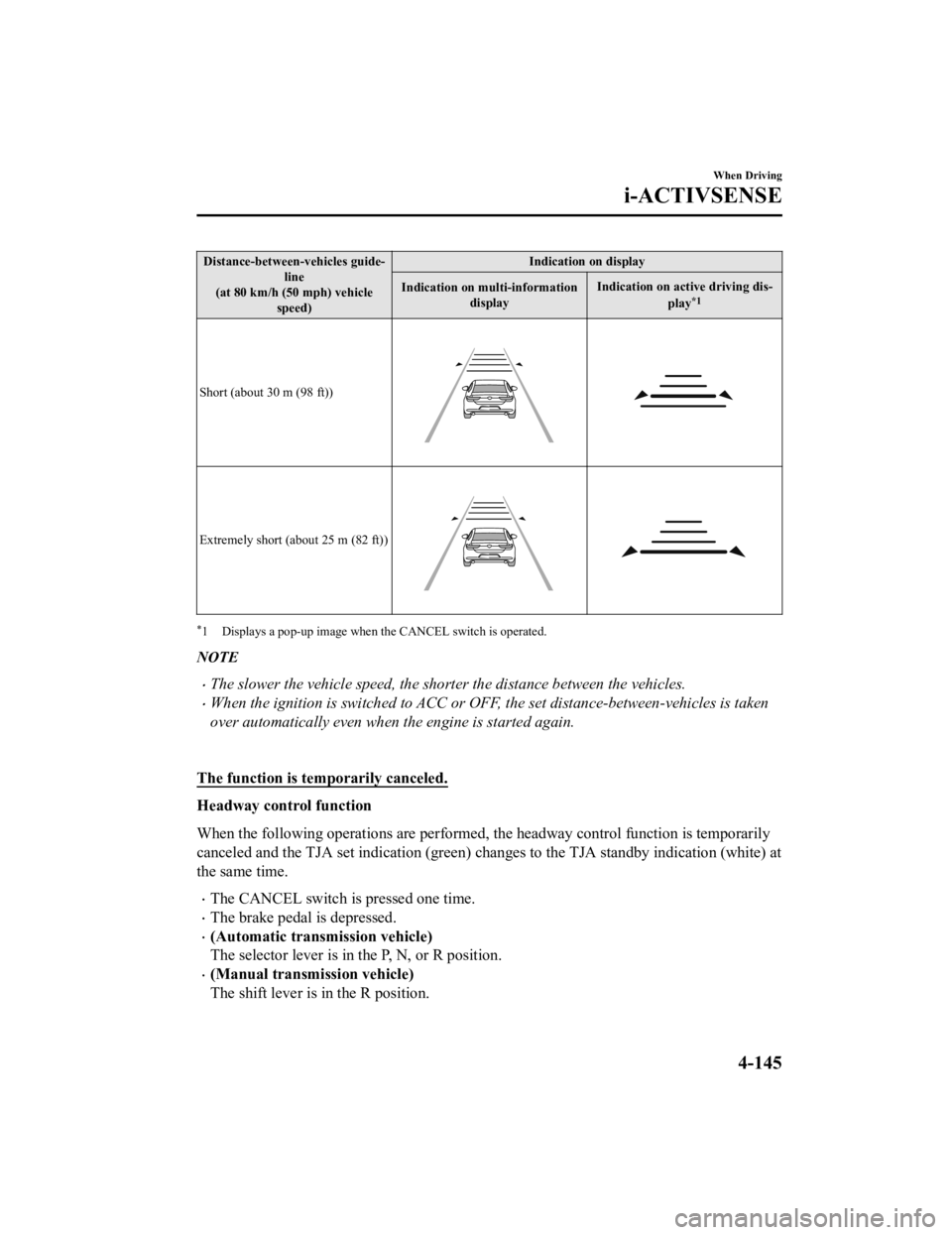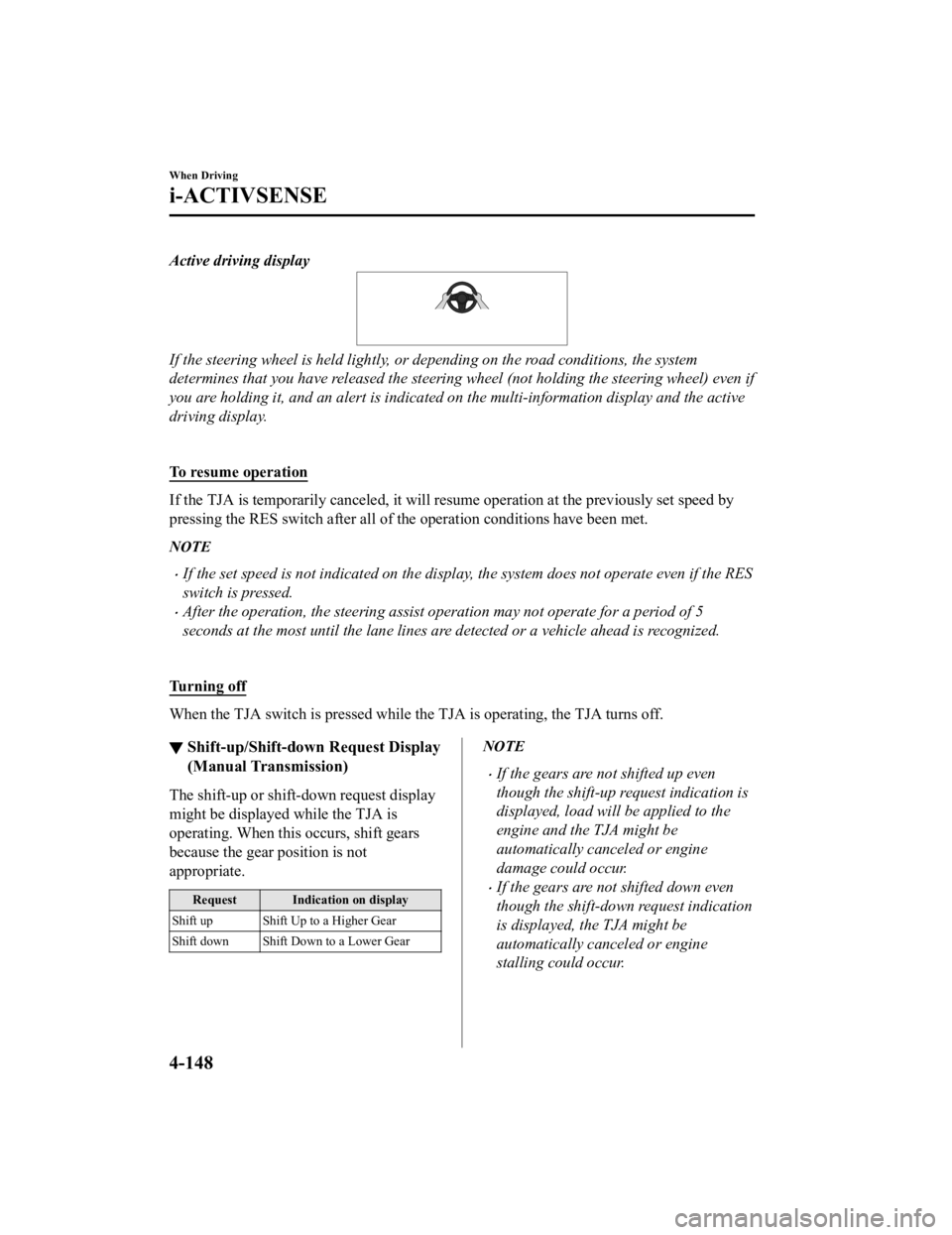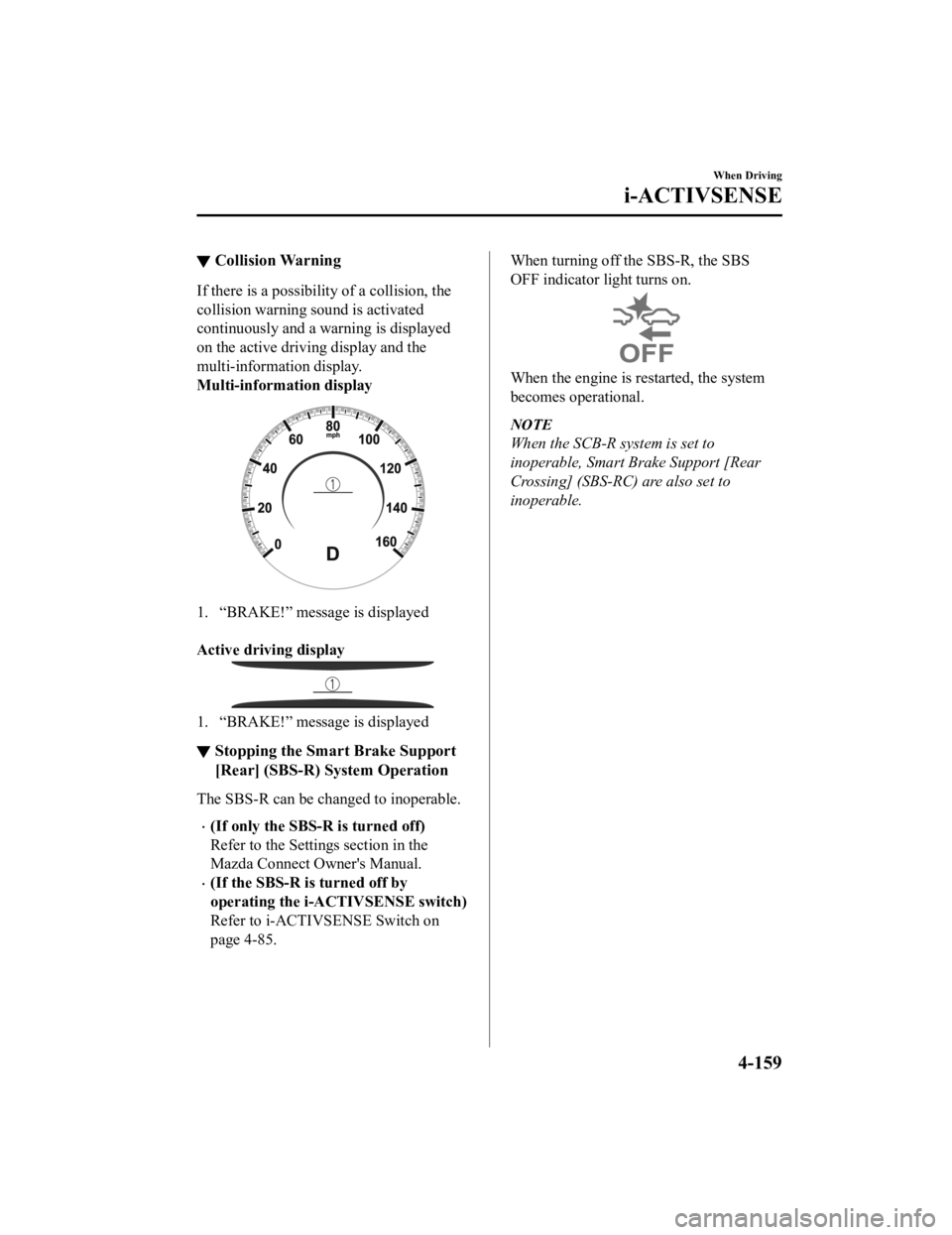engine MAZDA MODEL 3 SEDAN 2019 Manual PDF
[x] Cancel search | Manufacturer: MAZDA, Model Year: 2019, Model line: MODEL 3 SEDAN, Model: MAZDA MODEL 3 SEDAN 2019Pages: 592, PDF Size: 75.35 MB
Page 277 of 592

If a vehicle ahead is traveling at an
extremely low speed, the system may
not detect it correctly.
If there is a structure on the road or an
object (such as a monorail) at a low
height off the ground in front of the
vehicle, the system may operate.
Therefore, do not use the TJA.
Do not use the TJA under conditions in
which close proximity warnings are
frequently activated.
If it is necessary to accelerate for a lane
change or the vehicle ahead brakes
suddenly causing you to close in on the
vehicle rapidly, accelerate using the
accelerator pedal or decelerate using
the brake pedal depending on the
conditions.
While the TJA is in use, it does not
cancel even if the selector lever is
operated and any intended engine
braking does not occur. If deceleration
is required, lower the set speed or
depress the brake pedal.
You might hear the sound of the
automatic brakes operating; however, it
does not indicate a problem.
The brake lights turn on while the TJA
automatic braking is operating.
Under the following conditions, the TJA
may not be able to detect white (yellow)
lines correctly and the TJA may not
operate normally.
The forward sensing camera (FSC)
cannot recognize the area in front of
the vehicle due to soiling or fog.
The white (yellow) lane lines are less
visible because of dirt or paint
flaking.
White (yellow) lane lines are less
visible because of bad weather (rain,
fog, or snow).
The vehicle is driven on a temporary
lane or section with a closed lane
resulting from construction where
there might be multiple white (yellow)
lane lines, or they are interrupted.
The camera picks up an obscure line,
such as a temporary line being used
for construction, or because of shade,
unmelted snow, or grooves filled with
water.
The road surface is wet and shiny
after rain, or there are puddles on the
road.
Heavy luggage is loaded in the
luggage compartment or on the rear
seat causing the vehicle to tilt.
A vehicle in front of your vehicle is
running near a white (yellow) lane
line making it less visible.
The windshield is dirty or foggy.
The tire pressures are not adjusted to
the specified pressure.
Tires other than standard tires are
equipped.
The vehicle is driven through an
intersection, a junction, or a fork in
the road.
While white (yellow) lane lines cannot
be detected due to road or weather
conditions.
The surrounding brightness suddenly
changes such as when entering or
exiting a tunnel.
The illumination of the headlights is
weakened because of dirt or the
optical axis is deviated at night.
Back-light is reflected off the road
surface or the road surface is wet and
shiny after rain.
When Driving
i-ACTIVSENSE
4-137
Mazda3_8HE9-EA-18K_Edition3 2018-11-21 14:31:58
Page 281 of 592

▼Setting the System
Operation conditions
Headway control function
The headway control function ope
rates when all of the following conditions are met.
(Automatic transmission vehicle)
The vehicle speed is about 0 km/h (0 mph) to 145 km/h (90 mph).
(Manual transmission vehicle)
The vehicle speed is about 30 km/h (19 mph) to 145 km/h (90 mph ).
The TJA is operating.
The headway control function of the Mazda Radar Cruise Control (MRCC) or Mazda
Radar Cruise Control with Stop & Go function (MRCC with Stop & Go function) is set to
operable (if it was set to inope rable, set it to operable using the personalization function).
The brake pedal is not depressed.
The parking brake is released (E lectric Parking Brake (EPB) indicator light is turned off).
All the doors are closed.
The driver's seat belt is fastened.
(Automatic transmission vehicle)
The selector lever is in the D or M position (manual mode).
(Manual transmission vehicle)
The shift lever is in a position other than the R or N position .
The clutch pedal is not depressed.
NOTE
(Automatic transmission vehicle)
Under the following conditions, the TJA cannot be used when the vehicle speed is 30 km/h
(20 mph) or slower. In addition, a message, “Mazda Radar Cruise Control Disabled
Under 30 km/h (20mph)” is displayed in the multi-information display.
The forward sensing camera (FSC) cannot detect target objects (windshield is damaged
or dirty).
There is a problem with the stop hold control function.
There is a problem with the Electric Parking Brake (EPB).
The TJA may not launch directly after the engine starts.
When Driving
i-ACTIVSENSE
4-141
Mazda3_8HE9-EA-18K_Edition3 2018-11-21 14:31:58
Page 285 of 592

Distance-between-vehicles guide‐line
(at 80 km/h (50 mph) vehicle speed) Indication on display
Indication on multi-information display Indication on active driving dis‐
play
*1
Short (about 30 m (98 ft))
Extremely short (about 25 m (82 ft))
*1 Displays a pop-up image when the CANCEL switch is operated.
NOTE
The slower the vehicle speed, the shorter the distance between the vehicles.
When the ignition is switched to ACC or OFF, the set distance-between-vehicles is taken
over automatically even when the engine is started again.
The function is temporarily canceled.
Headway control function
When the following operations are performed, the headway contro l function is temporarily
canceled and the TJA set indication (green) changes to the TJA standby indication (white) at
the same time.
The CANCEL switch is pressed one time.
The brake pedal is depressed.
(Automatic transmission vehicle)
The selector lever is in the P, N, or R position.
(Manual transmission vehicle)
The shift lever is in the R position.
When Driving
i-ACTIVSENSE
4-145
Mazda3_8HE9-EA-18K_Edition3 2018-11-21 14:31:58
Page 286 of 592

In the following cases, the TJA cancel indication is displayed and a sound is activated one
time.
The DSC has operated.
The Smart Brake Support (SBS) has operated.
The vehicle is driven on a downslope for a long time.
There is a problem with the system.
The front radar sensor cannot detect target objects (during rai n, fog, snow or other
inclement weather conditions, or when the radiator grille is dirty).
The parking brake is applied.
Any of the doors is opened.
The driver's seat belt is unfastened.
(Automatic transmission vehicle)
The parking brake is automatical ly applied during stop hold control.
(Manual transmission vehicle)
The vehicle speed decreases below 25 km/h (15 mph).
The shift lever is in the neutral position for a certain period of time.
The clutch pedal is depressed for a certain period of time.
The engine has stalled.
Steering assist function
If any of the fo llowing conditions occurs, the steering assist function is temporarily
canceled.
White (yellow) lane lines cannot be detected or a vehicle ahead cannot be recognized.
CANCEL switch is pressed.
Your vehicle speed is more than about 64 km/h (40 mph).
The brake pedal is depressed.
The accelerator pedal is operated.
The turn signal lever is operated.
The vehicle is making a sharp curve.
The width of a lane is excessively narrow or wide.
The vehicle crosses a lane line.
(Automatic transmission vehicle)
The selector lever is in the P, N, or R position.
(Manual transmission vehicle)
The shift lever is in the R position.
In the following cases, the TJA cancel indication is displayed and a sound is activated one
time.
When Driving
i-ACTIVSENSE
4-146
Mazda3_8HE9-EA-18K_Edition3 2018-11-21 14:31:58
Page 287 of 592

The DSC has operated.
The ABS/TCS/DSC is operating.
The Smart Brake Support (SBS) has operated.
The parking brake is applied.
Any of the doors is opened.
The driver’s seat belt is unfastened.
The driver takes his/her hands off the steering wheel.
The vehicle is driven on a downslope for a long time.
The steering wheel is operated abruptly.
There is a problem with the system.
The temperature in the Forward Sensing Camera (FSC) is high or low.
The windshield around the Forwar d Sensing Camera (FSC) is foggy.
The windshield around the Forward Sensing Camera (FSC) is blocked by an obstruction,
causing poor forward visibility.
The front radar sensor cannot det ect target objects (during rain, fog, snow or other
inclement weather conditions, or when the radiator grille is dirty).
(Automatic transmission vehicle)
The parking brake is automatically applied during stop hold con trol.
(Manual transmission vehicle)
The vehicle speed decreases below 25 km/h (15 mph).
The shift lever is in the neutral position for a certain period of time.
The clutch is depressed for a certain period of time.
The engine has stalled.
NOTE
If you take your hands off the steering wheel (not holding the steering wheel), the warning
sound is activated and an alert is indicated on the multi-information display and the active
driving display.
Multi-information display
When Driving
i-ACTIVSENSE
4-147
Mazda3_8HE9-EA-18K_Edition3 2018-11-21 14:31:58
Page 288 of 592

Active driving display
If the steering wheel is held lightly, or depending on the road conditions, the system
determines that you have released the steering wheel (not holding the steering wheel) even if
you are holding it, and an alert is indicated on the multi-information display and the active
driving display.
To resume operation
If the TJA is temporarily cancel ed, it will resume operation at the previously set speed by
pressing the RES switch after a ll of the operation conditions have been met.
NOTE
If the set speed is not indicated on the displa y, the system does not operate even if the RES
switch is pressed.
After the operation, the steering assist ope ration may not operate for a period of 5
seconds at the most until the lane lines are detected or a vehicle ahead is recognized.
Turning off
When the TJA switch is pressed w hile the TJA is operating, the TJA turns off.
▼Shift-up/Shift-down Request Display
(Manual Transmission)
The shift-up or shift-down request display
might be displayed while the TJA is
operating. When this occurs, shift gears
because the gear position is not
appropriate.
Request Indication on display
Shift up Shift Up to a Higher Gear
Shift down Shift Do wn to a Lower Gear
NOTE
If the gears are not shifted up even
though the shift-up request indication is
displayed, load will be applied to the
engine and the TJA might be
automatically canceled or engine
damage could occur.
If the gears are not shifted down even
though the shift-down request indication
is displayed, the TJA might be
automatically canceled or engine
stalling could occur.
When Driving
i-ACTIVSENSE
4-148
Mazda3_8HE9-EA-18K_Edition3 2018-11-21 14:31:58
Page 295 of 592

If a malfunction is detected or the
system temporarily stops the function
due to dirty sensors (such as radar
sensor or Forward Sensing Camera
(FSC)), the i-ACTIVSENSE warning
indication/warning light turns on and a
message is displayed on the
multi-information display and active
driving display.
On a manual transmission vehicle, the
engine stops if the clutch pedal is not
depressed when the vehicle is stopped by
the SBS brake operation.
If the vehicle is stopped by the SBS
brake operation and the brake pedal is
not depressed, the SBS brake is
automatically released after about 2
seconds.
▼ Collision Warning
When there is a possib
ility of a collision
with a vehicle ahead, the collision warning
sound is activated continuously and a
warning is displayed on the
multi-information display and the active
driving display.
Multi-information display
1. “BRAKE!” message is displayed
Active driving display
1. “BRAKE!” message is displayed
NOTE
The collision warning sound is activated
intermittently while the SBS brake or
brake assist (SBS brake assist) is
operating.
The operation distance and volume of
the collision warning can be changed.
Refer to the Settings section in the
Mazda Connect Owner's Manual.
▼ Stopping the Smart Brake Support
(SBS) System Operation
The SBS can be changed to inoperable.
(If only the SBS is turned off)
Refer to the Settings section in the
Mazda Connect Owner's Manual.
(If the SBS is turned off by operating
the i-ACTIVSENSE switch)
Refer to i-ACTIV
SENSE Switch on
page 4-85.
When turning off the SBS, the SBS OFF
indicator light turns on.
NOTE
If the engine is stopped with the SBS
turned off, the SBS becomes operational
when the engine is started the next time.
When Driving
i-ACTIVSENSE
4-155
Mazda3_8HE9-EA-18K_Edition3 2018-11-21 14:31:58
Page 297 of 592

Do not apply a strong force to a rear
ultrasonic sensor and rear camera:
When washing the vehicle, do not spray
highly pressurized water against a rear
ultrasonic sensor and rear camera, or rub it
strongly. In addition, do not hit the rear
bumper forcefully when loading and
unloading cargo Otherwise, the sensors
may not detect obstructions correctly
which could cause the SBS-R system to not
operate normally, or it could operate
unnecessarily.
CAUTION
When driving
off-road in areas where
there is grass or foliage, it is
recommended that the SBS-R system be
turned off.
Always use tires of the specified size and
the same manufacturer, brand, and
tread pattern on all 4 wheels. In addition,
do not use tires with significantly
different wear patterns on the same
vehicle. Otherwise, the SBS-R system may
not operate normally.
If ice or snow is stuck on the rear
ultrasonic sensor and rear camera they
may not be able to detect obstructions
correctly depending on the conditions. In
such cases, the system may not be able
to perform controls correctly. Always
drive carefully and pay attention to the
rear of the vehicle.
NOTE
The vehicle posture changes depending
on the accelerator pedal, brake pedal
and steering wheel operations, which
could make it difficult for the system to
recognize an obstruction, or it could
facilitate unnecessary detection. In such
cases, the SBS-R may or may not
operate.
The SBS-R system will operate under the
following conditions.
The engine is running.
The shift lever (manual transmission
vehicle) or the selector lever
(automatic transmission vehicle) is in
the R (reverse) position.
The slope is less than 5 %.
i-ACTIVSENSE warning indication/
warning light is no t displayed in the
multi-information display.
The vehicle speed is between about 2
to 8 km/h (2 to 4 mph).
The SBS-R is not turned off.
The DSC is not malfunctioning.
In the following cases, the rear
ultrasonic sensor and rear camera
cannot detect obstructions and the
SBS-R may not operate.
The height of the obstruction is low
such as low walls or trucks with low
loading platforms.
The height of the obstruction is high
such as trucks with high loading
platforms.
The obstruction is small.
The obstruction is thin such as a
signpost.
The surface of the obstruction is not
pointed vertically relative to the
vehicle.
When Driving
i-ACTIVSENSE
4-157
Mazda3_8HE9-EA-18K_Edition3 2018-11-21 14:31:58
Page 298 of 592

The obstruction is soft such as a
hanging curtain or snow stuck to a
vehicle.
The obstruction is shaped irregularly.
The obstruction is extremely close.
In the following cases, the rear
ultrasonic sensor and rear camera
cannot detect obstructions correctly and
the SBS-R may not operate.
Something is stuck on the bumper
near a rear ultrasonic sensor.
The brake or accelerator pedal is
operated.
There is another obstruction near one
obstruction.
During inclement weather such as
rain, fog and snow.
High or low humidity.
High or low temperatures
Strong winds.
The path of travel is not flat.
Heavy luggage is loaded in the
luggage compartment or on the rear
seat.
Objects such as a wireless antenna,
fog light, or illuminated license plate
is installed near a rear ultrasonic
sensor.
The orientation of a rear ultrasonic
sensor has deviated for reasons such
as a collision.
The vehicle is affected by other sound
waves such as the horn, engine noise,
ultrasonic sensor of another vehicle.
In the following cases, a rear ultrasonic
sensor and rear camera may detect
something as a target obstruction which
could cause the SBS-R system to
operate.
Driving on a steep slope.
Wheel blocks.
Hanging curtains, gate poles such as
at toll gates and railroad crossing.
When traveling near objects such as
foliage, barriers, vehicles, walls, and
fences along a road.
When driving off-road in areas where
there is grass and forage.
When passing through low gates,
narrow gates, car washing machines,
and tunnels.
A trailer is connected.
A bright light source such as sunlight
hits the rear camera.
The surroundings are dark.
An exterior accessory such as a
bicycle carrier is installed around the
rear sonar.
(Manual transmission)
If the vehicle is stopped by the SBS-R
operation and the clutch pedal is not
depressed, the engine stops.
When the system operates, the user is
notified by the multi-information
display.
The collision warning beep sounds
intermittently while the SBS-R brake is
operating.
If the vehicle is stopped by the SBS-R
operation and the brake pedal is not
depressed, displaying in meter
“Emergency Braking Activated. Depress
Brake Pedal to Hold Stop”, after about
2 seconds and the SBS-R brake is
automatically released.
When Driving
i-ACTIVSENSE
4-158
Mazda3_8HE9-EA-18K_Edition32018-11-21 14:31:58
Page 299 of 592

▼Collision Warning
If there is a possibility of a collision, the
collision warning sound is activated
continuously and a warning is displayed
on the active driving display and the
multi-information display.
Multi-information display
1. “BRAKE!” message is displayed
Active driving display
1. “BRAKE!” message is displayed
▼Stopping the Smart Brake Support
[Rear] (SBS-R) System Operation
The SBS-R can be changed to inoperable.
(If only the SBS-R is turned off)
Refer to the Settings section in the
Mazda Connect Owner's Manual.
(If the SBS-R is turned off by
operating the i-ACTIVSENSE switch)
Refer to i-ACTIVSENSE Switch on
page 4-85.
When turning off the SBS-R, the SBS
OFF indicator light turns on.
When the engine is restarted, the system
becomes operational.
NOTE
When the SCB-R system is set to
inoperable, Smart Brake Support [Rear
Crossing] (SBS-RC) are also set to
inoperable.
When Driving
i-ACTIVSENSE
4-159
Mazda3_8HE9-EA-18K_Edition3
2018-11-21 14:31:58